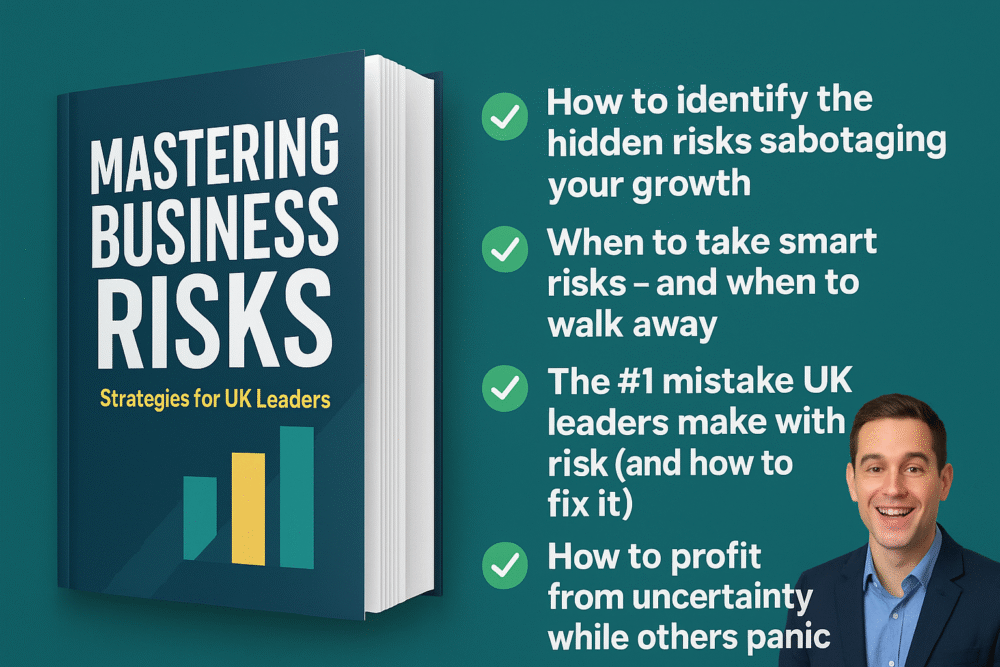Discounting UK Products and Services: A Strategic Approach to Business Survival and Growth During Economic Hardship
In August 2024, the UK business environment faces significant challenges, with economic conditions described as turbulent and uncertain. Business leaders are grappling with high levels of debt, declining consumer confidence, and a slowdown in economic activity. In this context, discounting products and services emerges as a vital strategy for both B2B (business-to-business) and B2C (business-to-consumer) sectors. As a business risk management expert, I advise UK business leaders on the benefits of discounting, not just as a survival tactic, but as a growth strategy that can protect and expand their businesses during these difficult financial times.
This article explores the reasons behind the current UK economic malaise, the strategic advantages of discounting, and the importance of joining networks like the BusinessRiskTV.com Business Risk Management Club for expert guidance and support.
The Current State of the UK Business Environment in August 2024
Exploring current and future UK economic risks.
The Mountain of Government Debt: A Major Economic Burden
As of August 2024, the UK is experiencing a challenging economic environment characterised by a mountain of government debt. The national debt has reached record levels, driven by years of borrowing to fund public services, pandemic recovery programmes, and recent initiatives aimed at mitigating the impact of global economic shocks, including geopolitical tensions and supply chain disruptions. The rising interest rates have exacerbated the cost of servicing this debt, placing further strain on public finances and limiting the government’s ability to stimulate economic growth.
The high levels of government debt have several adverse effects on the business environment:
– Reduced Government Spending: To manage the debt burden, the government has been and will be forced to cut back on spending, particularly in areas that directly affect businesses, such as infrastructure development, subsidies, and public sector contracts. This reduction in spending translates into lower demand for goods and services from private businesses, impacting revenue and profitability.
– Increased Taxes: To finance the debt and maintain essential services, the government has had to consider increasing taxes, both on businesses and individuals. Higher corporate taxes reduce the net income of businesses, while increased personal taxes reduce disposable income for consumers, leading to a decrease in overall demand.
Commercial Debt and the Impact on Business Operations
In addition to government debt, many businesses in the UK are also struggling with high levels of commercial debt. During the low-interest rate era, businesses took on significant debt to finance expansion and operations. However, with the recent hikes in interest rates, the cost of servicing this debt has increased, squeezing cash flows and reducing the financial flexibility of businesses.
– Cash Flow Constraints: High levels of debt mean that a significant portion of business revenue is directed toward debt servicing rather than being reinvested into the business. This limits the ability of businesses to invest in growth initiatives, research and development, and employee training, all of which are crucial for long-term competitiveness.
– Credit Crunch: Banks and financial institutions have become more cautious in lending due to the economic uncertainty and the high levels of existing debt in the corporate sector. This credit crunch limits the ability of businesses to access much-needed working capital, further exacerbating financial strain.
Consumer Debt and Declining Consumer Confidence
The third pillar of the debt mountain affecting the UK business environment is consumer debt. Many UK households are heavily indebted, with high levels of mortgage debt, credit card debt, and personal loans. Rising interest rates have increased the cost of servicing this debt, leading to a reduction in disposable income and a decrease in consumer spending.
– Reduced Consumer Spending: With more income being directed toward debt repayments, consumers have less money to spend on goods and services. This reduction in consumer spending directly affects businesses, particularly those in the B2C sector, leading to lower sales and revenue.
– Decreased Consumer Confidence: High levels of debt, coupled with economic uncertainty and inflationary pressures, have led to a decline in consumer confidence. Consumers are more cautious with their spending, prioritising essential items and cutting back on discretionary purchases. This shift in consumer behavior poses a significant challenge for businesses, particularly those that rely on discretionary spending.
The Strategic Advantage of Discounting in a Downturn
Given the challenging economic environment outlined above, discounting products and services can be a strategic move for businesses looking to survive and thrive during these difficult times. Here’s why:
Attracting Price-Sensitive Customers
In an economic downturn, consumers and businesses alike become more price-sensitive. Households facing reduced disposable income prioritise value for money, and businesses with tight budgets seek cost-effective solutions. By offering discounts, businesses can attract these price-sensitive customers, increasing foot traffic and sales volumes.
– Increased Sales Volume: While discounting may reduce the profit margin on individual sales, it can lead to an increase in overall sales volume. Higher sales volumes can compensate for lower margins, helping businesses maintain or even increase their revenue during tough times.
– Improved Cash Flow: By moving inventory faster and increasing sales, businesses can improve their cash flow, which is critical for meeting short-term financial obligations, such as payroll, rent, and debt repayments.
Building Customer Loyalty and Trust
Discounting is not just about cutting prices; it’s also about creating value for customers. By strategically offering discounts, businesses can build customer loyalty and trust, which are essential for long-term success.
– Customer Retention: Offering discounts, especially to existing customers, can strengthen customer loyalty. During economic hardship, customers are more likely to stay with brands that provide them with perceived value. Loyal customers are also more likely to recommend a business to others, generating positive word-of-mouth and driving new customer acquisition.
– Enhancing Brand Perception: Discounts can also enhance brand perception by positioning the business as customer-centric and responsive to economic conditions. A business that shows empathy and understanding by offering financial relief through discounts is likely to be viewed more favorably by customers.
Clearing Excess Inventory and Reducing Holding Costs
In uncertain economic times, businesses may face challenges in selling their inventory. Discounting can be an effective way to clear excess inventory and reduce holding costs.
– Reducing Holding Costs: Inventory holding costs can add up, particularly for products with a limited shelf life or those that are seasonally sensitive. By offering discounts, businesses can move this inventory quickly, reducing holding costs and minimising potential losses from unsold stock.
– Freeing Up Storage Space: Clearing out excess inventory also frees up storage space, allowing businesses to be more agile in responding to market demand and stocking up on high-demand products.
Competitive Differentiation in a Crowded Market
In a recessionary environment, competition among businesses intensifies as they vie for a shrinking pool of customers. Discounting can serve as a competitive differentiation strategy, helping a business stand out in a crowded market.
– Gaining Market Share: By offering discounts, businesses can attract customers away from competitors, gaining market share even in a shrinking market. This strategy is particularly effective for businesses that can leverage economies of scale to offer deeper discounts than their competitors.
– Building a Competitive Moat: Businesses that establish a reputation for offering value through discounts can build a competitive moat, making it more difficult for competitors to win over their customers.
Enhancing Supplier Relationships and Negotiating Power
Discounting can also strengthen relationships with suppliers and improve negotiating power.
– Volume Discounts from Suppliers: By increasing sales volume through discounts, businesses may be able to negotiate better terms with suppliers, such as volume discounts, extended payment terms, or exclusive deals. These improved terms can enhance the business’s cost structure and profitability.
– Stronger Supplier Partnerships: Demonstrating the ability to move large volumes of product can strengthen partnerships with suppliers, making them more willing to collaborate on marketing initiatives, product launches, and other joint efforts.
Implementing a Successful Discounting Strategy
While discounting offers several strategic benefits, it is crucial to implement a well-thought-out discounting strategy to avoid potential pitfalls. Here are some best practices for effective discounting:
Understand Your Costs and Margins
Before implementing a discounting strategy, it is essential to have a clear understanding of your costs and profit margins. Offering discounts without a solid grasp of your financials can lead to unintentional losses. Calculate the break-even point for each product or service to ensure that discounts do not erode profitability.
Segment Your Customer Base
Not all customers are motivated by the same factors. Segment your customer base to tailor your discounting strategy to different customer groups. For example, loyal customers might respond well to exclusive discounts or loyalty rewards, while new customers might be attracted by introductory offers or bundle deals.
Use Discounts Strategically
Rather than offering blanket discounts across all products or services, use discounts strategically to achieve specific business objectives. For instance, discounts can be targeted to:
– Clear out slow-moving inventory
– Drive traffic during off-peak times
– Promote new products or services
– Encourage bulk purchases
Communicate the Value Proposition
When offering discounts, it is crucial to communicate the value proposition clearly to customers. Highlight the benefits of the discount, such as cost savings, limited-time offers, or exclusive deals, to create a sense of urgency and encourage immediate action.
Monitor and Adjust the Strategy
Discounting is not a set-it-and-forget-it strategy. Continuously monitor the performance of your discounting efforts and be prepared to adjust the strategy based on results. Analyse sales data, customer feedback, and market conditions to refine your approach and maximise the impact of your discounts.
Join BusinessRiskTV.com Business Risk Management Club
In these challenging economic times, businesses need more than just discounting strategies to survive and thrive. They need access to expert advice, peer support, and comprehensive risk management tools. This is where joining the BusinessRiskTV.com Business Risk Management Club can make a significant difference.
Access to Expert Advice and Insights
The BusinessRiskTV.com Business Risk Management Club offers business leaders access to a wealth of expert advice and insights on navigating the complexities of the current UK business environment. Members benefit from regular updates on economic trends, risk management strategies, and innovative solutions tailored to the specific challenges facing UK businesses today.
Networking Opportunities with Like-Minded Leaders
In times of economic uncertainty, networking with like-minded business leaders can provide invaluable support and collaboration opportunities. The Business Risk Management Club facilitates connections between business leaders from various industries, allowing them to share experiences, discuss challenges, and collaborate on solutions. This peer-to-peer learning environment helps businesses gain new perspectives and strategies to tackle common issues.
Practical Tools and Resources for Risk Management
The club provides practical tools and resources designed to help businesses assess and manage risks more effectively. These include risk assessment frameworks, financial modelling tools, and scenario planning exercises that allow businesses to anticipate potential challenges and develop contingency plans. By equipping members with these resources, the club empowers them to make informed decisions that protect and grow their businesses during difficult financial times.
Exclusive Workshops and Training Sessions
Members of the BusinessRiskTV.com Business Risk Management Club have access to exclusive workshops and training sessions led by industry experts. These sessions cover a range of topics, from advanced discounting strategies and financial management to crisis communication and digital transformation. By participating in these workshops, business leaders can enhance their skills and stay ahead of the curve in a rapidly changing business landscape.
Staying Ahead of Regulatory Changes
Regulatory changes are an ever-present risk factor for businesses, particularly in times of economic uncertainty. The Business Risk Management Club keeps members informed of any regulatory developments that may impact their operations, ensuring that they remain compliant and avoid potential penalties. Staying informed about regulatory changes also allows businesses to anticipate and prepare for future challenges.
Collaborative Problem-Solving
The BusinessRiskTV.com Business Risk Management Club encourages collaborative problem-solving, enabling members to brainstorm and develop innovative solutions to shared challenges. By leveraging the collective knowledge and experience of the group, businesses can identify new opportunities and strategies to mitigate risks and drive growth. This collaborative approach fosters a sense of community and shared purpose among members, helping them navigate difficult times together.
Conclusion: Navigating the Economic Downturn Through Strategic Discounting and Collaboration
The economic challenges facing the UK in August 2024 are significant, with high levels of government, commercial, and consumer debt creating a difficult business environment. However, by adopting strategic discounting practices, businesses can attract price-sensitive customers, clear excess inventory, and differentiate themselves from competitors.
Moreover, joining a network like the BusinessRiskTV.com Business Risk Management Club provides business leaders with the expertise, resources, and support they need to navigate these challenges effectively. Through collaboration, continuous learning, and access to practical tools, businesses can not only survive but thrive during economic downturns.
By leveraging the benefits of discounting and joining a community of like-minded business leaders, UK businesses can protect their operations, manage risks more effectively, and position themselves for future growth. Now more than ever, strategic thinking and collaboration are key to overcoming adversity and building a resilient, prosperous business future.
Get help to protect and grow your business faster
Find out more
Subscribe for free business risk alerts and risk reviews
Connect with us
Read more business risk management articles for free
Connect with us
Read more:
1. Discount strategies for UK businesses
2. Surviving economic downturn UK
3. Business growth during UK recession
4. B2B discounting benefits UK
5. How to increase sales with discounts
6. Managing business risks in the UK
7. Financial strategies for UK businesses 2024 and 2025
8. Best practices for discounting products
9. Economic survival tips for UK companies
10. Business resilience in tough economic times
Key Tags and Hashtags:
1. #BusinessGrowth
2. #UKEconomy
3. #DiscountStrategy
4. #BusinessSurvival
5. #EconomicDownturn
6. #BusinessRiskManagement
7. #B2BMarketing
8. #SalesStrategies
9. #RecessionProof
10. #FinancialPlanning

















